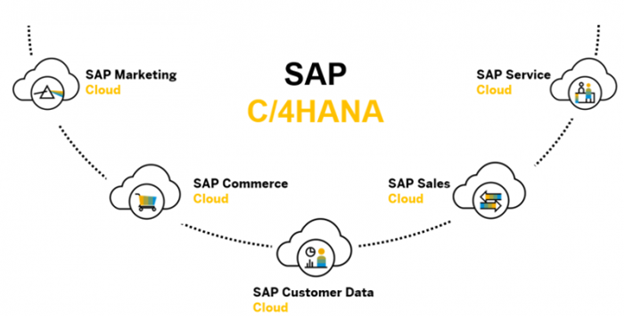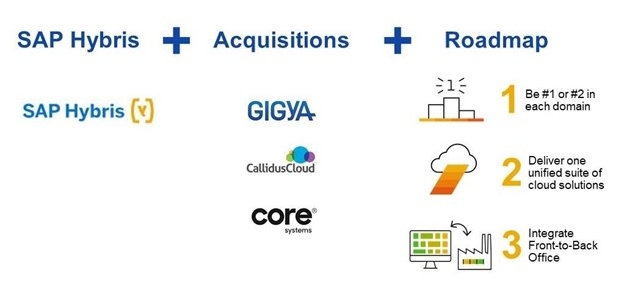 Anthony Cecchini is the President and CTO of Information Technology Partners (ITP), an ERP technology consulting company headquartered now in Virginia, with offices in Herndon. ITP offers comprehensive planning, resource allocation, implementation, upgrade, and training assistance to companies. Anthony has over 20 years of experience in SAP business process analysis and SAP systems integration. ITP is an Appian, Pegasystems, and UIPath Low-code and RPA Value Added Service Partner. You can reach him at [email protected].
Anthony Cecchini is the President and CTO of Information Technology Partners (ITP), an ERP technology consulting company headquartered now in Virginia, with offices in Herndon. ITP offers comprehensive planning, resource allocation, implementation, upgrade, and training assistance to companies. Anthony has over 20 years of experience in SAP business process analysis and SAP systems integration. ITP is an Appian, Pegasystems, and UIPath Low-code and RPA Value Added Service Partner. You can reach him at [email protected].
In 2013, SAP laid the foundation for C/4HANA CRM, which is a customer relationship management (CRM) software. It did so by first acquiring Hybris, an e-commerce software provider.
In 2015, the company started moving its solutions to the S/4HANA. It also began developing new customized solutions for all business sectors. In 2018, SAP officially announced the market introduction of the C/4HANA after the successful acquisition of several third-party software companies to boost the functionalities of the CRM software it had acquired from Hybris.
C/4HANA CRM is the customer experience suite from SAP. This suite comes with solutions that will change the traditional CRM environment as it currently runs.
SAP understood that a business relationship with clients does not end when they buy a product. As such, C/4HANA encourages positive customer experiences through every stage of a client’s relationship with your business. It also generates a consistent experience on all channels through which customers associate with your business while giving your real-time data to guide decision making.
SAP C/4HANA set out to revolutionize CRM solutions by combining marketing and front-office operations with business applications and back-end transactional ERP solutions. These applications are interconnected via the SAP cloud platform then embedded with technologies such as machine learning and AI using SAP Leonardo.
C/4HANA comprises five clouds, each covering a specific CRM section. The right mix of C/4HANA components can help ensure that a company achieves a faster return on their customer experience investment.
The clouds include:
- SAP customer data cloud
- SAP sales cloud
- SAP service cloud
- SAP marketing cloud
- SAP commerce cloud

SAP Customer Data Cloud
Client data is among the essentials that guide decision making in businesses. Some companies have the right tools for collecting this data but have no idea how to apply it in their operations. Others only collect their data from one source, meaning they have inadequate information for unbiased decision making. Consumers are, on the other hand, looking for a personalized experience. With the right data from all relevant sources, you understand the behavior of your target market. The heightened understanding allows you to customize your products and marketing campaigns according to your target market needs.
The customer data cloud in SAP C/4HANA allows you to build comprehensive customer profiles. Even so, data collection under this solution can only be done following explicit permission from the client. The customer data cloud also has an in-built permission management system that allows transparency when collecting data. Above all, this solution uses a GDPR-compliant consent-based customer data model that guarantees the privacy of the data you collect.
Other than data collection, C/4HANA’s customer data has the following capabilities:
- Social logins
- Customized registration
- User engagement and loyalty
- Preference management.
SAP Sales Cloud
This solution will transform the operations of your sales team by allowing the sale of products from anywhere, anytime, and on any device. The SAP sales cloud under C/4HANA uses artificial intelligence to forecast, report, and collect data. Artificial intelligence allows you to track customers through every step of their buying decision and push them towards a purchase. The following are some tools of the cloud that help it achieve its objectives.
- A lead scoring tool that shows the probability of a client’s conversion. This makes it possible to get new leads within your current and non-existing accounts.
- An opportunity scoring tool that scores sales opportunities, so your team knows the chances of winning a contract. Your sales team can use the scores to determine the opportunities in which they should invest.
- An influencer map that recommends the team members that are best-suited to help close a deal. This makes it easy to pick a winning sales team for specific transactions.
The other capabilities of the SAP sales cloud include:
- Sales performance management
- Homepage customization
- Sales overviews
- Predictive analytics
- Configure-price-quote
SAP Service Cloud
The service cloud helps you meet your clients’ expectations while increasing your company’s productivity. There are several tools under this cloud, but they are integrated into a single interface. This means that employees need not switch between screens to handle different issues. Moreover, the service cloud works with the commerce cloud. This gives a complete picture of a client’s order history to ease the services and products that your company recommends. Here are the tools under C/4HANA’s service cloud:
- A field service management tool: With this, field service technicians can fix issues quickly and give clients the right information about your services and products. The off and online alternatives for the field service management tool allow technicians to use it without a constant internet connection.
- Self-service capability tool: With this tool, customers can scan their QR codes on mobile phones. They can also engage with conversational AI chat bots and request product maintenance.
SAP Marketing Cloud
The marketing cloud increases the productivity of employees while giving you a better understanding of clients. Understanding your target market helps you determine where you should focus your marketing efforts and the channels to use. The C/4HANA marketing cloud also allows the unifying of data from multiple channels into one place for a 360-degree view of clients.
Some of the leading features of the marketing cloud are:
- Target group identifications.
- Discovery and visualization tools.
- Single unified customer view.
- Multichannel campaigns.
- Customer omnichannel experiences.
SAP Commerce Cloud
The commerce cloud in C/4HANA allows business owners to control their customer service, communication, and sales processes. This way, they can optimize their customer experiences when dealing with in-store or online sales. Furthermore, the commerce cloud offers clients an unhindered view of your services and products. This allows you to cross-sell your merchandise, promote items, and optimize your offerings for online searches.
The assisted customer 360-degree view included in C/4HANA’s commerce cloud enhances the personalization of your clients’ services. With it, you can see your in-store clients and give them the best recommendations on the products you have based on the data you have collected.
Other offerings of the commerce cloud include:
- Experienced management tool
- Omnichannel storefront.
- Order management solution.
CIOs considering SAP C/4HANA, or SAP Customer Experience, implementations will need to make decisions about which components they want, which deployment choices are right for them and the specific implementation tools they’ll use.
To help guide those decisions, here’s advice on those critical areas and what helps to make a C/4HANA deployment successful.
Choose SAP deployment options to boost customer experience
Whether public cloud, private cloud or on premises, primarily depends on which C/4HANA components a company chooses to implement and how well they integrate with a company’s existing infrastructure. For example, Sales Cloud and Service Cloud are only available in public cloud; there’s no on-premises deployment available. Commerce Cloud is not only available on premises but also in private cloud. Marketing Cloud is available in all three deployment options — public cloud, private cloud and on premises — and can also be integrated with SAP CRM or even SAP ERP Central Component (ECC). But an integration prerequisite is that the on-premises CRM or ECC needs to run on a HANA database.
Choosing among public or private cloud and on premises largely depends on a company’s internal security policies, as well as budget considerations. It is far less expensive to implement SAP C/4HANA components in a public cloud than in a private cloud or even on premises. Another advantage of using public cloud is that there’s a routine and scheduled maintenance upgrade that enables the companies to always use the latest version of C/4HANA. Other advantages of the public cloud are that it takes much less time to deploy and the bar for the skills required for specific C/4HANA components is set relatively low.
The downsides of using a public cloud are that there aren’t many customization options available, and companies also have to follow the maintenance upgrade schedule of SAP. In contrast to public cloud, companies have complete freedom and flexibility to choose their own maintenance and upgrade schedule in a private cloud or for on-premises deployment options. They also have a number of configuration and customization options to meet a company’s business needs.
Choose SAP Rapid Deployment Solutions or SAP Best Practices
There are several Rapid Deployment Solutions (RDS) available that are specific to implementing different components of C/4HANA. An RDS is a fixed-scope, fixed-deliverable and fixed-fee engagement service offered by SAP professional services. Companies that want C/4HANA for specific or unique business requirements will need to engage SAP partners for their implementation. In contrast to SAP RDS, SAP Best Practices for C/4HANA implementation entail following a step-by-step approach. SAP Best Practices are available for Commerce Cloud, Marketing Cloud, Sales Cloud and also Service Cloud.
Summary & FAQ
Customer experience (CX) is the new frontier at the top of the boardroom agenda. The most successful companies understand that achieving high customer lifetime value is the result of consistently delivering excellent customer service and customer experience. SAP C/4HANA is SAP’s fourth-generation in-memory customer experience suite that addresses the shift from legacy sales-only CRM products and instead focuses on the consumer. It lets businesses know in real time what their customer needs and can tap into the digital core of SAP S/4HANA in a way only SAP can.
The following are the answers to FAQs among business owners on this CRM solution.
Is C/4HANA a simple rebranding for SAP Hybris?
No, SAP C/4HANA is not the rebranded form of SAP Hybris. Hybris was the first software company to be acquired by SAP for the development of C/4HANA. There are, however, other companies that were acquired later to boost the software’s functionality. These include Gigya, CallidusCloud, and Coresystems. C/4HANA is thus a comprehensive suite of cloud-based solutions to transform your CRM.

Does C/4HANA need S/4HANA to work?
No, C/4HANA can integrate with ECC and S/4HANA. The C/4HANA solutions can be individually deployed with or without integration to an SAP ERP solution like S/4HANA.
Do you have to get all the five solutions in C/4HANA?
No, the solutions in C/4HANA can be deployed in combination or as standalone products. You can thus choose to invest only in those that guarantee your business the highest returns.





